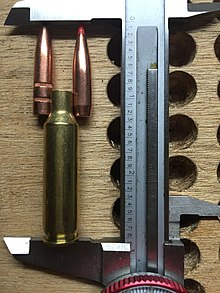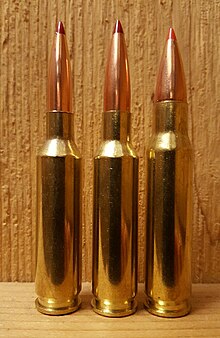Category: Ammo
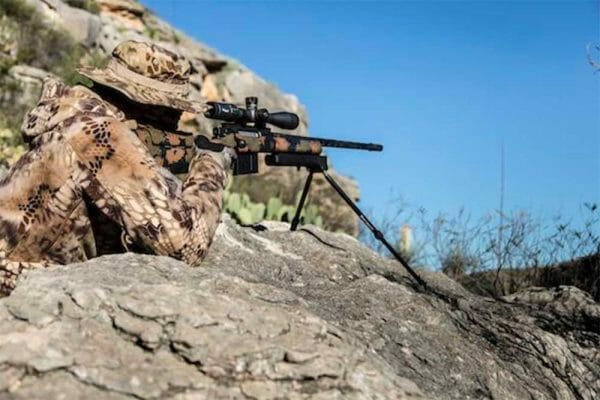
Gainesville, GA –-(Ammoland.com)- For the long-distance hunter, success in the field always begins at the shooting range. It would be great if every shooting range was designed so you could practice from 100 yards all the way out to 1,000 yards. The reality though, is that most ranges only offer rifle venues out to 100 yards, especially older ranges built before long-range shooting became so prevalent.
A shorter range doesn’t have to limit your preparation though. Using a ballistic calculator like Ballistic, your practice time at 100 yards can effectively prepare you for that longer-range shot in the field.
When you get to your range, enter your basic inputs into Ballistic, including bullet weight and type, atmospheric conditions, and sight height. Then, using your hunting rifle-optic set up, plus your hunting ammunition, zero your rifle at 100 yards, generating as tight a three- to five-shot group as possible.
Now, use a high-quality chronograph to determine your muzzle velocity; ten shots through the chronograph will provide the ammunition’s average velocity. Add this velocity number to your Ballistic inputs.
The next steps is to mimic field conditions with realistic game animal targets. While standard target practice is important, game animals don’t have bullseyes pasted to their vital zones. So, set up a life-sized animal target (there are many available today) at your 100-yard distance. Most of the better realistic targets even have the vital zones outlined. Once you can effectively place your shots where needed, switch to a smaller animal target. A one-half- or one-quarter-sized game animal target will help prepare you for what the animal will look like in the field, at distance, through your scope.
Once you get to your actual hunting area input your 100-yard zero into your Ballistic workup for your load, and it will show you the bullet’s drop at various distances. Let’s say the 200-yard listing shows a 2.5-inch drop from the 100-yard zero. Adjust the elevation on your optic according, in this case plus 2.5-inches, and you should be right on at 200 yards. Lastly, always make sure to redo your Atmospheric inputs for local conditions, and Ballistic will provide the precise data you need to take your trophy at long distance.
About Ballistic
Ballistic is the definitive ballistics trajectory calculator, intended for long-range and precision shooters who want a serious–and a seriously accurate–application. Ballistic will calculate your bullet’s trajectory, windage, velocity, energy, lead, and flight time for any valid range. The app can also compensate for atmospheric conditions such as temperature, barometric pressure, humidity, and altitude–it can even accept density of air or density altitude inputs! The world-renowned JBM Ballistics engine powers all Ballistic computations. Ballistic is used by competition shooters, long-range hunters, and the military to deliver the most precise calculations possible.
With Ballistic, you’ll be able to make the most accurate calculations for every shot, everywhere, even in areas with no cellular coverage.
Don't Underestimate the . 30 – 30
Here is some more info about a under rated and long gone Rifle Round. That i found on the net. Enjoy Grumpy!
.218 Bee
by | January 4th, 2011
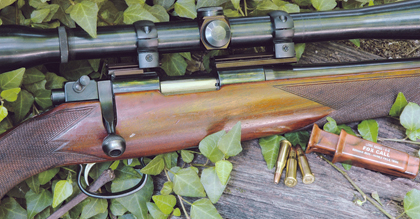 |
Most of the rifle cartridges introduced during these past few years have been given rather boring names, but there was a time when the name of a cartridge combined with a bit of imagination went a very long way. A mere mention of the .22 Hornet, .219 Zipper, .220 Swift, .17 Mach IV, .221 Fireball or .219 Wasp brought visions of fast bullets, flat trajectories and memorable days spent in fields full of targets.
Another cartridge capable of reaching across the back 40 and stinging a varmint is the .218 Bee. It came about in 1938 when Winchester, looking to boost the sagging sales of its Model 92 rifle, added the .218 Bee—failing to recognize that, even back then, hunters wanted their varmint cartridges in bolt actions and single-shots, not lever actions. As it turned out, only a few Model 92s were chambered for the new cartridge, but it managed to find a permanent home in a variation of the Model 92 called the Model 65.
The Bee case is a necked-down .25-20 Winchester (itself a necked-down version of the .32-20 Winchester). Only one factory load was offered: a 46-grain hollowpoint at 2,860 fps.
At the time, the .22 Hornet was loaded with a 45-grain bullet at 2,690 fps, and the .22 Hornet has enjoyed far greater popularity among varmint shooters, probably because it was introduced first and it has been available in a greater variety of rifles. But the .218 Bee is superior to it in several ways.
For starters it is a bit faster, which gives it a longer effective range. Those of us who have handloaded both cartridges also know that due to the thicker wall of the Bee case, it is less susceptible to neck collapse during bullet seating than the Hornet. Another benefit to the thicker brass is longer case life for the .218 Bee when both cartridges are loaded to maximum velocities.
On the negative side, the Bee also arrived with a handicap that may have prevented it from shining more brightly. Whereas the Hornet was designed for use in bolt-action rifles, the Bee was designed for a rear-locking lever action rifle, and for this reason it was loaded to lower chamber pressure. Had both cartridges been loaded to the same pressure, the Bee would have been at least another 100 fps faster than the Hornet.
Then we have the matter of bullet shape. Since the Bee was designed for a rifle with a tubular magazine, Winchester and Remington always loaded it with blunt-nosed bullets, whereas the Hornet was commonly loaded with pointed bullets. Even though a bullet fired from the Bee started out faster, its trajectory and downrange punch differed very little from the Hornet.
The first and one of only three bolt-action rifles chambered for the .218 Bee was the Winchester Model 43. Introduced in 1944, it was also offered in .22 Hornet, .25-20 and .32-20. The Model 43 was a nice little rifle and often described as the poor man’s Model 70, but those I owned in .22 Hornet and .218 Bee years ago were nowhere near as accurate as my Winchester models 54 and 70 in .22 Hornet.
The jewel among bolt-action Bees, and one that will hold its own with the Model 70 in accuracy, is the dainty little Sako L46. The small number of those rifles chambered to .218 Bee serves to illustrate the lack of popularity of the cartridge. I bought one during the 1960s, and much later during a visit to the Sako factory I was told that only 50 had been built in that caliber, and I’ve seen only two in many years of looking at Sako rifles.
Back in 1986 the original Kimber of Oregon did a limited run of Model 82 rifles in .218 Bee, and also offered an improved version called the .218 Mashburn Bee.
Greg Warne sent me one of the first standard Bees, and I found it to be quite accurate. Rather than going to the expense of building a detachable magazine for a cartridge that would probably not sell a lot of rifles, Greg decided to make Model 82s in that caliber single-shots with a solid-bottom receiver. Like the Winchester Model 43 and the Sako L46, the Kimber Model 82 allowed the use of pointed bullets in .218 Bee handloads, which improved its performance over factory ammunition.
Not too many other rifles have been available in .218 Bee. Back in the 1930s Marlin offered it in its Model 90, an over-under combination gun with one barrel in .410 and the other in .218 Bee. Marlin tried again in 1990 by offering it in it Model 1894 carbine, and along about the same time Browning introduced a Japanese copy of the Winchester Model 92 in the same caliber. The Thompson/Center custom shop continues to offer the Bee in the Contender carbine, and as far as I know, that’s about the size of it as rifles of current production go.
When it comes to choosing powders for .218 Bee handloads, IMR-4227 has long been a popular choice, and H4227 works equally well. Also often recommended is slightly quicker burning 2400, but it borders on being too fast, making it tricky to work with in this cartridge.
Moving to the opposite extreme, IMR-4198, H4198 and Reloder 7 work okay with 45-grain bullets, but you usually run out of case capacity before reaching top velocities with lighter bullets. When all is said and done, H110 and W296—along VihtaVuori N120—offer the best combination of bulk density and burn rate available for bullets weighing from 30 to 45 grains in the .218 Bee.
Several blunt-nosed bullets are suitable when loading the .218 Bee for a lever-action rifle with tubular magazine. They include the 46-grain flatnose from Speer and three bullets of roundnose form: the 45-grain Hornet bullets from Nosler and Sierra and Sierra’s 40-grain Hornet.
| A FEW GOOD .218 BEE LOADS | ||||
|---|---|---|---|---|
| Bullets for Lever Actions | Bullet Weight (gr.) | Power Type | Charge Weight (gr.) | Muzzle Velocity |
| Sierra Hornet * | 40 | IMR 4227 | 13.3 | 2,810 |
| Nosler Hornet * | 45 | H110 | 11.5 | 2,722 |
| Sierr a Hornet * |
45 | V-N120 | 14.2 | 2,684 |
| Speer FN * | 46 | RL7 | 14.5 | 2,749 |
| Bullets For Bolt Actions | ||||
| Berger Varmint | 30 | H110 | 12.3 | 3,144 |
| Hornady V-Max | 35 | V-N120 | 14.5 | 3,067 |
| Sierra BlitzKing | 40 | IMR 4227 | 13.3 | 2,892 |
| Nosler Ballistic Tip | 40 | W296 | 11.8 | 2,876 |
| Speer PSN | 40 | H110 | 11.8 | 2,911 |
| Sierra SPT | 45 | RL7 | 14.5 | 2,817 |
*Blunt noses of these bullets make them suitable for use in a tubular magazine. Notes: These Loads are Maximum and powder charges should be reduced by 10 percent for starting loads. Velocities shown represent five or more rounds clocked 12 feet from the muzzle of a Marlin Model 1894CL with 20-inch barrel (lever action rifle loads) and a Sako L46 with 24-inch barrel. Winchester cases and CCI 400 primers were used in all loads. WARNING The loads shown here are safe only in the guns for which they were developed. Neither the author nor InterMedia Outdoors assumes any liability for accidents or injury resulting from the use or misuse of this data. Shooting reloads may void any warranty on your firearm. |
||||
Best choices in pointed bullets for use in bolt actions and single-shots are those weighing from 30 to 45 grains from Berger, Nosler, Sierra, Speer and Hornady. I am especially fond of the 30-grain Berger hollowpoint and the 40-grain BlitzKing, Ballistic Tip and V-Max bullets in this cartridge.
Bullets heavier than 45 grains can be used, but most rifles in .218 Bee have barrels with a rifling twist rate of 1:16 inches, which can be too slow to stabilize them in flight.
It saddens me to say this, but the future of the .218 Bee is looking less than bright. Remington dropped it from production several years ago, and Winchester makes only an occasional production run of ammo and unprimed cases.
If ammo and case production should cease, you’ll have to neck down .25-20 or .32-20 cases. The .25-20 can be squeezed down to .22 caliber in one step with a .218 Bee full-length resizing die, but the .32-20 requires an extra form die available from Redding. Attempting to neck it down in one step usually results in a collapsed case.
Here’s hoping the .218 Bee will continue to buzz over the varmint fields for many years to come.
Read more: http://www.rifleshootermag.com/ammo/ammunition_rs_0108_09/#ixzz5JbEXgykC
A Sellier & Bellot ammo review

In the spirit of Transparency
(What ever the F**K that is!)
I want to let you know that I have have used this brand for a very long time. As usually it is very cheap and for the price that is sold at very good.
In plain English that means that it is fairly accurate and does not leave a huge mess in your gun after using it. Unlike some other major league Brands that I could mention. But do not want to get sued by!
And no I am not getting a kick back from them. But I do have a Paypal Button by the way. If somebody wants to help with my financial affairs!
Grumpy
PS Most of the time today. When I stock up on ammo. I usually go to a Gunshow.
As you will usually get a better deal than at your local Gun Emporium. Who has a much higher overhead than the guys at the show!
Classic Ammo – The 6.5mm Creedmoor
| 6.5mm Creedmoor | ||||||||||||
|---|---|---|---|---|---|---|---|---|---|---|---|---|
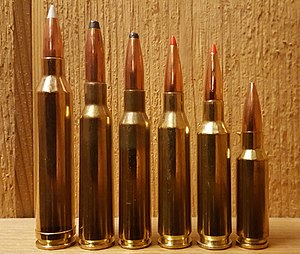
Size comparison of some 6.5mm cartridges, left to right: .264 Winchester Magnum, 6.5×55mm Swedish, 6.5×52mm Carcano, .260 Remington, 6.5mm Creedmoor, 6.5mm Grendel
|
||||||||||||
| Type | Centerfire rifle | |||||||||||
| Place of origin | United States | |||||||||||
| Production history | ||||||||||||
| Designed | 2007 | |||||||||||
| Manufacturer | Hornady | |||||||||||
| Produced | 2008 | |||||||||||
| Specifications | ||||||||||||
| Parent case | .30 TC | |||||||||||
| Case type | Rimless, bottleneck | |||||||||||
| Bullet diameter | .2644 in (6.72 mm) | |||||||||||
| Neck diameter | .2950 in (7.49 mm) | |||||||||||
| Shoulder diameter | .4620 in (11.73 mm) | |||||||||||
| Base diameter | .4703 in (11.95 mm) | |||||||||||
| Rim diameter | .4730 in (12.01 mm) | |||||||||||
| Rim thickness | .054 in (1.4 mm) | |||||||||||
| Case length | 1.920 in (48.8 mm) | |||||||||||
| Overall length | 2.825 in (71.8 mm) | |||||||||||
| Case capacity | 52.5 gr H2O (3.40 cm3) | |||||||||||
| Rifling twist | 1-8″ (203 mm) | |||||||||||
| Primer type | Large rifle, Small rifle (Lapua and Starline brass) |
|||||||||||
| Maximum pressure (C.I.P.) | 63,100 psi (435 MPa) | |||||||||||
| Maximum pressure (SAAMI) | 62,000 psi (430 MPa) | |||||||||||
| Ballistic performance | ||||||||||||
|
||||||||||||
| Test barrel length: 28 inch[not in citation given] Source(s): Hornady,[1] SAAMI,[2][3] C.I.P. [4][5] |
||||||||||||
The 6.5mm Creedmoor, designated 6.5 Creedmoor by SAAMI, 6,5 Creedmoor by the C.I.P. or 6.5 CM or 6.5 CRDMR for short, is a centerfire rifle cartridge introduced by Hornady in 2007[6] as a modification of the .30 TC,[7] which was based on the .308 Winchester[8]. It was designed specifically for long-range target shooting,[6] although it is also achieving success in game hunting.[7] Bullet for bullet, the 6.5mm Creedmoor achieves a slower muzzle velocity than longer cartridges such as the 6.5-284 Normaor magnum cartridges such as the 6.5mm Remington Magnum. However, due to its 2.825 inches (71.8 mm) overall length, it is capable of being chambered in short-action bolt-action rifles and AR-10 semi-automatic rifles.
Contents
[hide]
Design considerations[edit]
6.5 mm (.264″) bullets, in general, are known for their relatively high sectional density[7] and ballistic coefficients, and have seen success in rifle competition. For some loads the 6.5mm Creedmoor is capable of duplicating the muzzle velocity[2] or trajectory[9] of the .300 Winchester Magnum while generating significantly lower recoil, based on lighter projectile weight. As this cartridge is designed for a bolt face diameter of .473 inches (roughly 12 mm), conversion of a short action rifle to another caliber (such as the .22-250 Remington, .243 Winchester or .300 Savage) with similar bolt face diameter generally requires little more than a simple barrel change.
Performance[edit]
This is a medium power cartridge often compared to the .260 Remington and 6.5×47mm Lapua.[10] Three hundred yard energy using 129 grain Hornady SST bullets is listed by an independent reviewer as 1641 ft. lbs.[11] For the 140 grain bullet at 2700 feet per second initial velocity another reviewer reports an MPBR[12] for a six inch high target of 265 yards and reports a manufacturer claim of “almost 1600 ft. lbs.” of retained energy at 300 yards using a 24-inch barrel.[13] SAAMI test data confirms 6.5 mm Creedmoor (fifteen feet from muzzle) velocity of 2,940 fps for the 129 grain bullet and 2,690 for the 140 grain bullet (which compares to .300 Winchester magnum data of 2,930 fps for a 200 grain bullet and 2,665 fps for a 210 grain bullet).[2] Long-range shooter Ray “RayDog” Sanchez summarized the bolt-action Tubb 2000 rifle in 6.5mm Creedmoor as “boringly accurate” at 1000 yards (914.4 metres). He asserted the rifle and ammunition combination he used was able to maintain sub-MOA groups at 1000 yards (914.4 metres).[14]
Handloading[edit]
Handloading cost for the 6.5 Creedmoor is roughly equivalent to other 6.5mm cartridges, such as the 6.5×47mm Lapua, due to the availability of Lapua small primer brass for both cartridges.[15][16] Norma now makes brass for the cartridge and as of 2017 Norma brass is available through several major retailers at approximately the same cost as Lapua brass. Lapua brass for 6.5×47 lasts about 12 to 20 reloads.[17] Starline sells brass cases with either large or small primer pockets, with small pocket brass costing slightly more.[18] When the 6.5 CM was first introduced it was advertised as a 60,000 psi capable case.[6]However, when it was placed into production Hornady listed it as 62,000 psi and had it SAAMI registered as such. For this reason many hand loaders have had poor experiences reloading for it. Blown primers on the first shot at 62,000 psi is not uncommon. Early shooting articles listed the ammo as loaded to 58,000 psi[19] but later ones list it as 57,000 psi.[20] This is because Hornady reduced the loads in its factory ammo because of complaints that it was often blowing primers.[21]Lapua delivered Creedmoor brass at Shot show 2017,[22] and production quantities became available via major retailers in second quarter 2017. The Lapua version has a small primer pocket.[15][23] Thus, loads from a Lapua Creedmoor should not be used in another manufacturer’s Creedmoor brass that features a large primer pocket without applying proper hand loading test for pressure first. Also the use of a smaller diameter decapping rod is required to size and decap.
Further developments[edit]
The 6mm Creedmoor is a necked-down version of the 6.5mm Creedmoor using 6mm (.243 inch) bullets, which are lighter than 6.5mm bullets with similarly reduced recoil. John Snow at Outdoor Life designed it in 2009. As of May 2018, Savage Arms offers 3 bolt action rifles and 1 semiautomatic rifle chambered in 6mm Creedmoor.[24] As of May 2018, Hornady offers 87 gr Varmint Express, 103 gr Precision Hunter and 108 gr Match ammunition in 6mm Creedmoor.[25]
Military use[edit]
In October 2017, U.S. Special Operations Command tested the performance of 7.62 NATO, .260 Remington, and 6.5 Creedmoor cartridges out of SR-25, M110A1, and Mk 20 sniper rifles. SOCOM determined that 6.5 Creedmoor performed the best, doubling hit probability at 1,000 meters, increasing effective range by nearly half, reducing wind drift by a third and having less recoil than 7.62 NATO rounds. Because the two rounds have similar dimensions, the same magazines can be used and a rifle can be converted with a barrel change. This led to its adoption and fielding by special operations snipers to replace the 7.62 NATO cartridge in their semi-automatic sniper rifles, planned in early 2019. In response to SOCOM’s adoption, the Department of Homeland Securityalso decided to adopt the round.[26][27]
